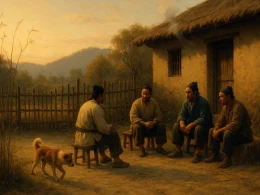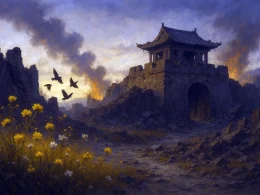The slender beauty's dressed in emerald all about
A thousand branches droop like fringes made of jade.
But do you know by whom these slim leaves are cut out?
The wind of early spring is sharp as scissor blade.
Original Poem
「咏柳」
贺知章
碧玉妆成一树高,万条垂下绿丝绦。
不知细叶谁裁出,二月春风似剪刀。
Interpretation
This poem, composed by He Zhizhang of the Tang Dynasty, is a lyrical ode to nature. With delicate brushstrokes, the poet depicts the tender willows of early spring, using the imagery to express his keen sensitivity to the beauty of the natural world. In his later years, after retiring from official duties and returning to his hometown, He Zhizhang paid particular attention to the subtle details of life. This poem is a celebration of the vitality of spring.
First Couplet: “碧玉妆成一树高,万条垂下绿丝绦。”
Bì yù zhuāng chéng yī shù gāo, wàn tiáo chuí xià lǜ sī tāo.
The tall willow tree is adorned with jade-green leaves; its countless hanging branches resemble flowing green ribbons.
The poet uses "jade-green" to describe the willow, emphasizing the vibrant freshness of its leaves while also evoking the image of a graceful young woman. The term "jade-green" not only refers to the color but also alludes to the literary trope of a "jade-green maiden," transforming the willow into a fresh and elegant figure. The "green ribbons" describe the gentle swaying of the willow branches, capturing their softness and movement.
Second Couplet: “不知细叶谁裁出,二月春风似剪刀。”
Bù zhī xì yè shuí cái chū, èr yuè chūn fēng shì jiǎn dāo.
Who crafted these delicate leaves? It is the spring breeze of February, like a pair of scissors carefully shaping them.
These lines personify the spring breeze as a tailor, skillfully crafting the willow's delicate leaves. The poet's rhetorical question leads to the answer, highlighting not only the intricacy of the leaves but also the wondrous artistry of nature. The metaphor "the spring breeze of February is like scissors" is both novel and imaginative, vividly bringing the intangible breeze to life and leaving readers in awe.
Overall Appreciation
The poem focuses on the willow tree, capturing its beauty while celebrating the marvels of nature. The poet ingeniously transforms stillness into motion, comparing the willow to a graceful maiden and the spring breeze to a skilled tailor. This vividly portrays the scene of early spring, where plants sprout and life renews. The poem's language is fresh and natural, its imagery lively and vibrant, imbued with a strong sense of life.
Writing Characteristics
- Clever Metaphors, Vivid Imagery: Comparisons like "jade-green" and "green ribbons" personify the willow, giving it the grace of a young woman and infusing the poem with a sense of liveliness.
- Personification, Full of Charm: The poet's rhetorical question "who crafted these delicate leaves?" personifies the spring breeze as a tailor, making the intangible forces of nature tangible and engaging.
- Scene and Emotion Intertwined: Through his praise of the willow and the spring breeze, the poet expresses his love and reverence for the vitality of nature.
Insights
This poem offers a unique perspective on the vibrant energy of early spring, reminding us to appreciate the often-overlooked beauty in life. By envisioning the spring breeze as "scissors," the poet assigns the role of creator to the forces of nature, encouraging us to approach the natural world with awe and gratitude. It inspires us to marvel at the wonders of life and the greatness of nature.
Poem translator
Xu Yuan-chong (许渊冲)
About the poet
He Zhizhang (贺知章) was a native of Xiaoshan, Zhejiang Province, circa 659-746 AD. He was admitted as a scholar in 695 AD. He returned to his hometown in 744 AD. He Zhizhang was open-minded, fond of talking and drinking.












